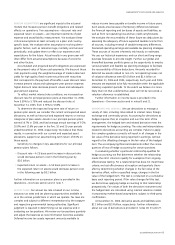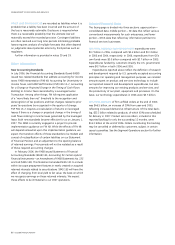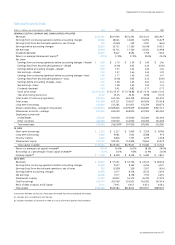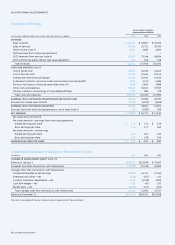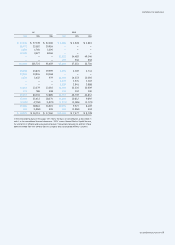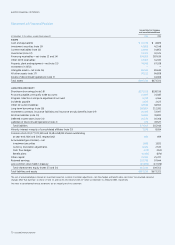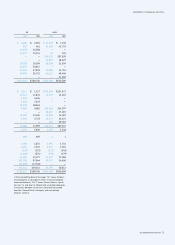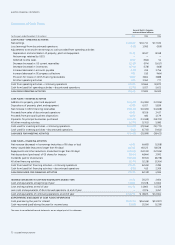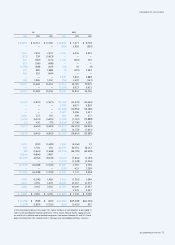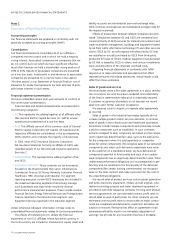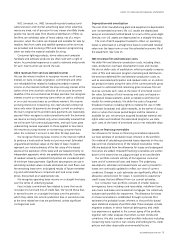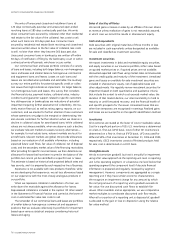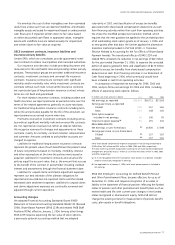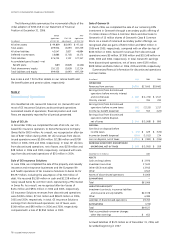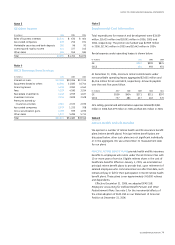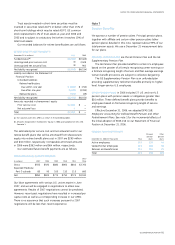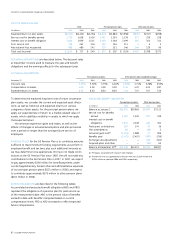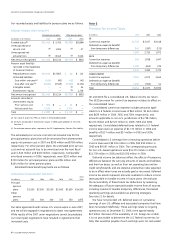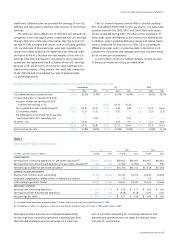GE 2006 Annual Report Download - page 77
Download and view the complete annual report
Please find page 77 of the 2006 GE annual report below. You can navigate through the pages in the report by either clicking on the pages listed below, or by using the keyword search tool below to find specific information within the annual report.
NBC Universal, Inc. (NBC Universal) records broadcast and
cable television and Internet advertising sales when advertise-
ments are aired, net of provision for any viewer shortfalls (make
goods). We record sales from theatrical distribution of fi lms as
the films are exhibited; sales of home videos, net of a return
provision, when the videos are shipped and available for sale by
retailers; fees from cable and satellite operators when services
are provided; and licensing of film and television programming
when we make the material available for airing.
Consumer lighting products, home videos and computer
hardware and software products are often sold with a right of
return. Accumulated experience is used to estimate and provide
for such returns when we record the sale.
GECS revenues from services (earned income)
We use the interest method to recognize income on all loans.
Interest on loans includes origination, commitment and other
non-refundable fees related to funding (recorded in earned
income on the interest method). We stop accruing interest at the
earlier of the time at which collection of an account becomes
doubtful or the account becomes 90 days past due. We recognize
interest income on nonearning loans either as cash is collected
or on a cost-recovery basis as conditions warrant. We resume
accruing interest on nonearning, non-restructured commercial
loans only when (a) payments are brought current according to
the loan’s original terms and (b) future payments are reasonably
assured. When we agree to restructured terms with the borrower,
we resume accruing interest only when reasonably assured that
we will recover full contractual payments, and such loans pass
underwriting reviews equivalent to those applied to new loans.
We resume accruing interest on nonearning consumer loans
when the customer’s account is less than 90 days past due.
We recognize financing lease income on the interest method
to produce a level yield on funds not yet recovered. Estimated
unguaranteed residual values at the date of lease inception
represent our initial estimates of the fair value of the leased
assets at the expiration of the lease and are based primarily on
independent appraisals, which are updated periodically. Guarantees
of residual values by unrelated third parties are considered part
of minimum lease payments. Significant assumptions we use in
estimating residual values include estimated net cash fl ows over
the remaining lease term, anticipated results of future remarket-
ing, and estimated future component part and scrap metal
prices, discounted at an appropriate rate.
We recognize operating lease income on a straight-line basis
over the terms of underlying leases.
Fees include commitment fees related to loans that we do
not expect to fund and line-of-credit fees. We record these fees
in earned income on a straight-line basis over the period to
which they relate. We record syndication fees in earned income
at the time related services are performed, unless signifi cant
contingencies exist.
Depreciation and amortization
The cost of GE manufacturing plant and equipment is depreciated
over its estimated economic life. U.S. assets are depreciated
using an accelerated method based on a sum-of-the-years digits
formula; non-U.S. assets are depreciated on a straight-line basis.
The cost of GECS equipment leased to others on operating
leases is amortized on a straight-line basis to estimated residual
value over the lease term or over the estimated economic life of
the equipment. See note 15.
NBC Universal film and television costs
We defer film and television production costs, including direct
costs, production overhead, development costs and interest.
We do not defer costs of exploitation, which principally comprise
costs of film and television program marketing and distribution.
We amortize deferred film and television production costs, as
well as associated participation and residual costs, on an individ-
ual production basis using the ratio of the current period’s gross
revenues to estimated total remaining gross revenues from all
sources; we state such costs at the lower of amortized cost or
fair value. Estimates of total revenues and costs are based on
anticipated release patterns, public acceptance and historical
results for similar products. We defer the costs of acquired
broadcast material, including rights to material for use on NBC
Universal’s broadcast and cable networks, at the earlier of acqui-
sition or when the license period begins and the material is
available for use. We amortize acquired broadcast material and
rights when we broadcast the associated programs; we state
such costs at the lower of amortized cost or net realizable value.
Losses on financing receivables
Our allowance for losses on fi nancing receivables represents
our best estimate of probable losses inherent in the portfolio.
Our method of calculating estimated losses depends on the size,
type and risk characteristics of the related receivables. Write-
offs are deducted from the allowance for losses and subsequent
recoveries are added. Impaired financing receivables are written
down to the extent that we judge principal to be uncollectible.
Our portfolio consists entirely of homogenous consumer
loans and of commercial loans and leases. The underlying
assumptions, estimates and assessments we use to provide for
losses are continually updated to reflect our view of current
conditions. Changes in such estimates can significantly affect the
allowance and provision for losses. It is possible to experience
credit losses that are different from our current estimates.
Our consumer loan portfolio consists of smaller balance,
homogenous loans including card receivables, installment loans,
auto loans and leases and residential mortgages. We collectively
evaluate each portfolio for impairment. The allowance for losses
on these receivables is established through a process that
estimates the probable losses inherent in the portfolio based
upon statistical analyses of portfolio data. These analyses include
migration analysis, in which historical delinquency and credit
loss experience is applied to the current aging of the portfolio,
together with other analyses that reflect current trends and
conditions. We also consider overall portfolio indicators including
nonearning loans, trends in loan volume and lending terms, credit
policies and other observable environmental factors.
ge 2006 annual report 75


